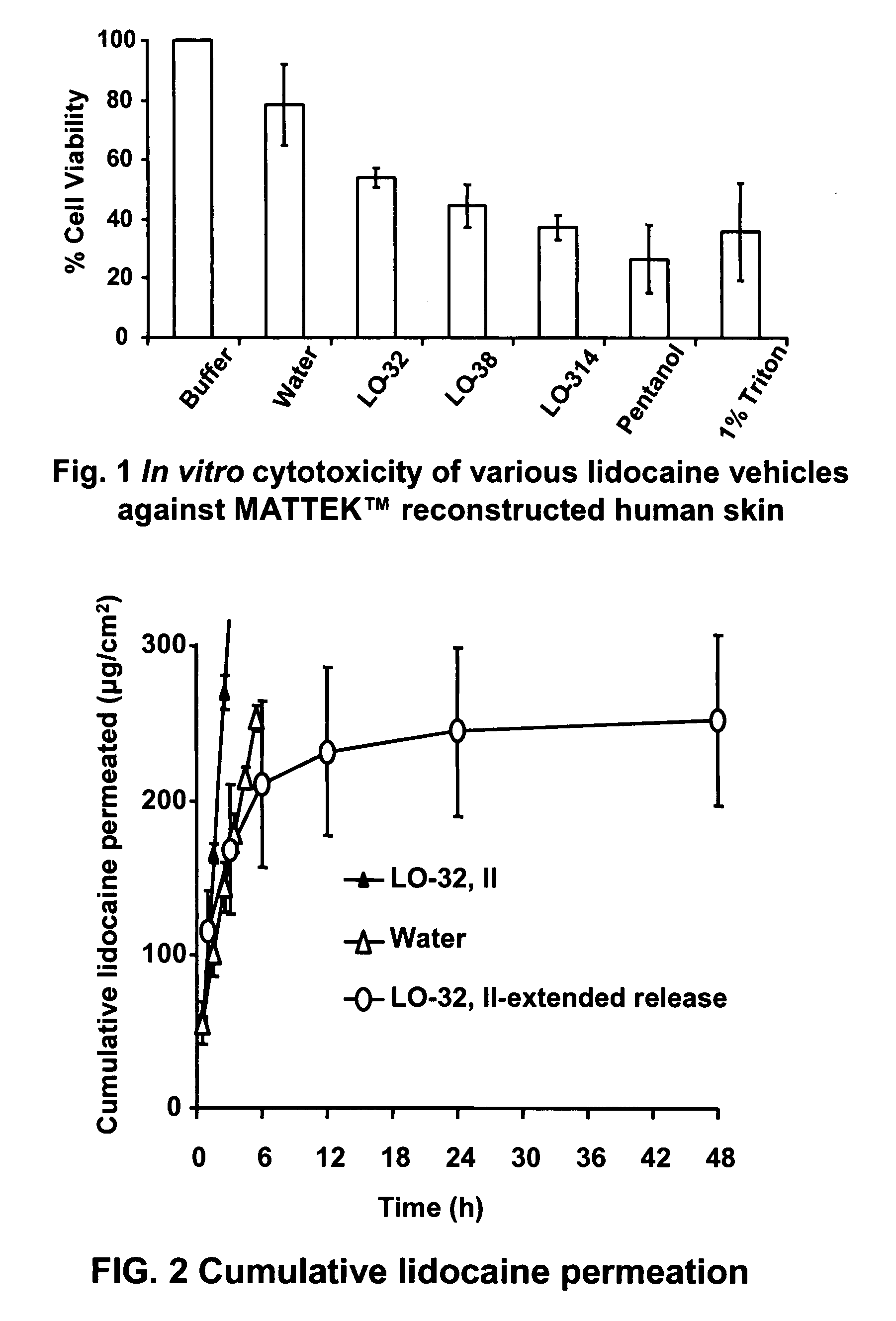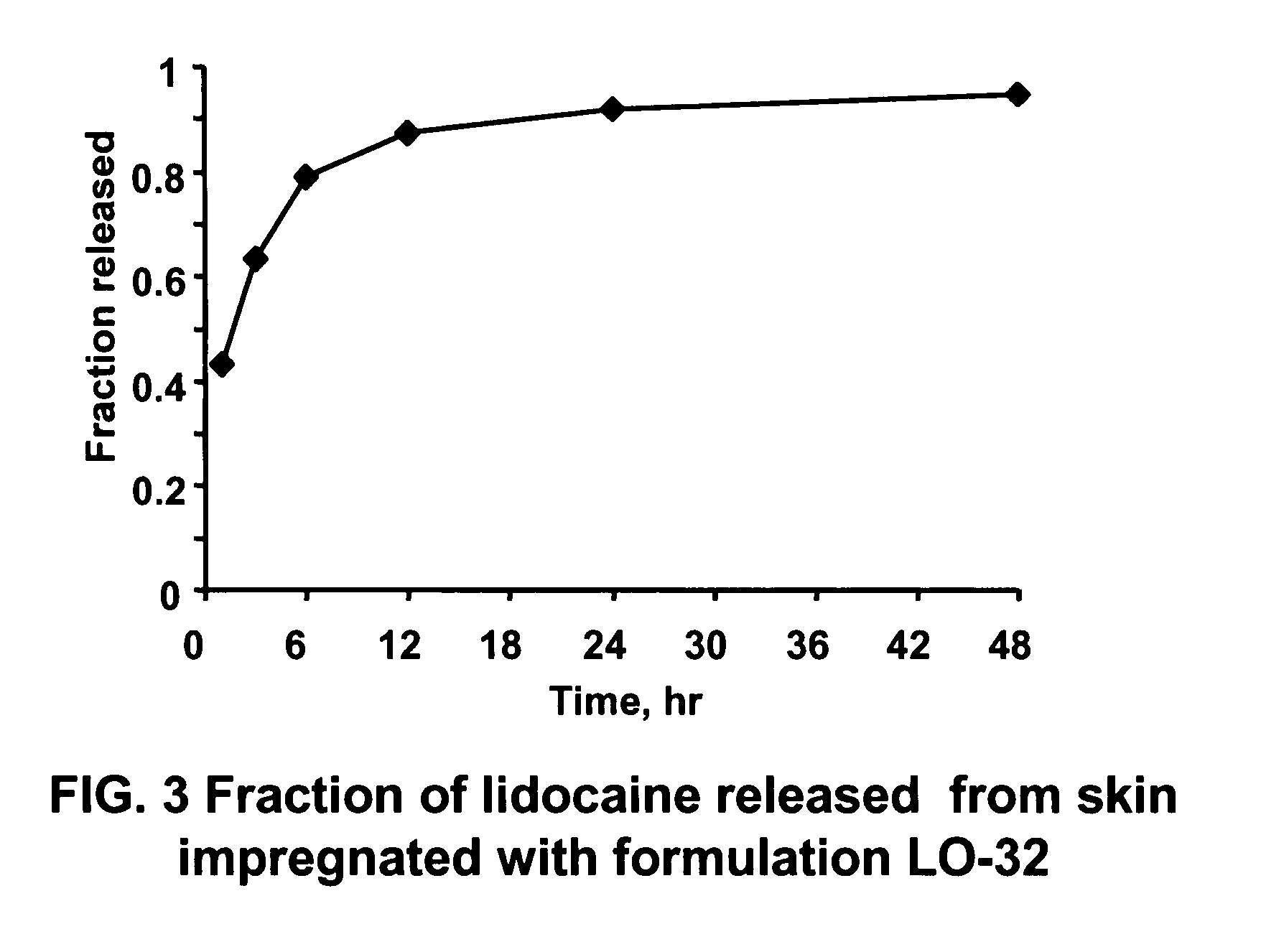Linker-Based Lecithin Microemulsion Delivery Vehicles
a technology of microemulsion and lecithin, which is applied in the direction of biocide, plant growth regulator, pharmaceutical non-active ingredients, etc., can solve the problems of co-solvent trigger allergic reactions, etc., and achieve the effects of increasing solubility, increasing absorption, and increasing solubility
- Summary
- Abstract
- Description
- Claims
- Application Information
AI Technical Summary
Benefits of technology
Problems solved by technology
Method used
Image
Examples
example 1
Lidocaine-ispropyl myristate Formulation
[0037]In these formulations, soybean-extracted lecithin was used as principal surfactant, at a concentration of 8% w / w in the initial aqueous solution. Sodium octanoate and octanoic acid were used as the hydrophilic linkers. The initial aqueous concentration of octanoic acid was 6% w / w. The initial aqueous concentration of sodium octanoate was increased from 1% w / w to 14% w / w at intervals of 1% w / w in each test tube. Sorbitan monooleate (Span 80) served as the lipophilic linker, and used at an initial aqueous concentration of 24% w / w. These microemulsion formulations were formed spontaneously by mixing appropriate quantities of the components with gentle mixing at room temperature. All microemulsion systems were thoroughly vortexed and allowed to equilibrate at 37° C. for at least two weeks, to allow phase equilibrium. A conventional Type II microemulsion formulation (P) with pentanol as a cosurfactant instead of linkers was also generated to ...
example 2
Lidocaine-ethyl caprate Formulation
[0043]The same formulation procedure of Example 1 was used, except that the carrier oil, ispopropyl myristate was replaced by ethyl caprate. Table 2 summarizes the composition and properties of these formulations. (Where: (a) is lecithin; (b) is sorbitan monooleate; (c) is octanoic acid; (d) is sodium octanoate; (e) is water; (f) is lidocaine; (g) is ethyl caprate; and (v) is microemulsion volume. Concentrations are expressed on a weight percentage basis (w / w).)
TABLE 2Composition and properties of lidocaine-ethyl caprate microemulsions.Series #% (a)% (b)% (c)% (d)% (e)% (f)% (g)TypeViscosity cP(v). mlLE-836.419.14.772.46.97.752.7II6.3LE-846.218.74.673.18.27.651.6II 7 + / − 16.4LE-855.817.54.383.613.27.148.3II6.9LE-865.717.14.294.314.37.047.3II7.0LE-875.315.83.964.620.16.543.7II16 + / − 27.6LE-884.012.03.004.039.05.033.0IV10.0LE-894.012.03.004.538.55.033.0IV22 + / − 410.0LE-8104.012.03.005.038.05.033.0IV10.0LE-8114.413.13.286.041.05.027.2I33 + / − 59.1LE-81...
example 3
Lidocaine-isopropyl myristate (IPM) Using glycerol monooleate as Lipophilic Linker
[0044]The same formulation procedure of Example 1 was used, except that the lipophilic linker, sorbitan monooleate (Span 80) was replaced by glycerol monooleate. (Where: (a) is lecithin; (b) is glycerol monooleate; (c) is octanoic acid; (d) is sodium octanoate; (e)-is water; (f) is lidocaine; (g) is isopropyl myristate; and (v) is microemulsion volume. Concentrations are expressed on a weight percentage basis (w / w).)
TABLE 3Composition and properties of lidocaine-IPM + glycerolmonooleate formulation.%Series #% (a)% (b)% (c)% (d)% (e)(f)% (g)Type(v). mlGM-15.817.44.350.716.77.148.0II6.9GM-26.319.04.761.67.97.752.6II6.3GM-35.917.64.412.214.07.248.7II6.8GM-45.516.44.112.719.26.745.4II7.3GM-55.115.23.803.224.76.241.9II7.9GM-64.714.13.533.529.45.838.9II8.5GM-74.012.03.003.539.55.033.0IV10.0GM-84.012.03.004.039.05.033.0IV10.0GM-94.714.03.495.244.85.022.9I8.6GM-104.914.83.706.246.95.118.4I8.1GM-115.215.63.907....
PUM
| Property | Measurement | Unit |
|---|---|---|
| aggregate size | aaaaa | aaaaa |
| permanent angle | aaaaa | aaaaa |
| concentrations | aaaaa | aaaaa |
Abstract
Description
Claims
Application Information
 Login to View More
Login to View More - R&D
- Intellectual Property
- Life Sciences
- Materials
- Tech Scout
- Unparalleled Data Quality
- Higher Quality Content
- 60% Fewer Hallucinations
Browse by: Latest US Patents, China's latest patents, Technical Efficacy Thesaurus, Application Domain, Technology Topic, Popular Technical Reports.
© 2025 PatSnap. All rights reserved.Legal|Privacy policy|Modern Slavery Act Transparency Statement|Sitemap|About US| Contact US: help@patsnap.com



